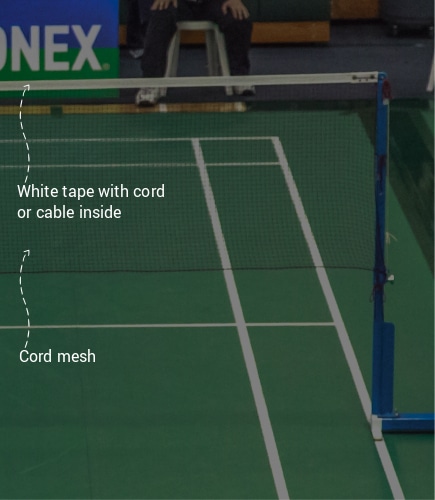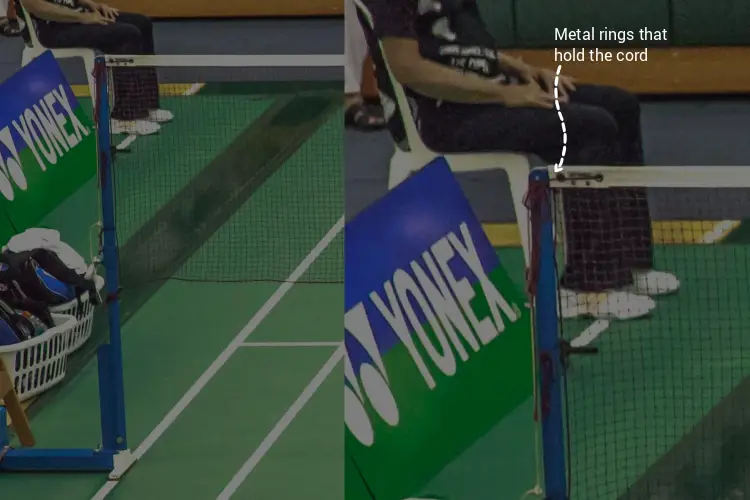Badminton nets are one of the most important parts of a game. Without a net, it is impossible to make the most out of badminton. But, what is a badminton net made of?
In general, badminton nets are made of a nylon mesh that covers the majority of the net. The main difference in the nets is the material used as a cord that will keep the net tensed. In this case, nylon can also be used, although in professional nets also steel cables are used.
Do you want to improve your badminton game? Then be sure to sign up for Badminton Famly+ by clicking here. Founded by former World Champion Thomas Laybourn, Badminton Famly+ is the best online training platform for badminton.
If you want to learn a bit more about the materials and variations, be sure to read on.
What is a badminton net made of? The in-depth answer
As I said before, badminton nets are made of a cord mesh that is topped with a cord or cable covered in white tape. In the image below you can see a visual representation of this.

This file is licensed under the Creative Commons license “Attribution-ShareAlike 4.0 International”.
Attribution: Murray Foubister, Wikimedia, CC BY-SA 4.0
As you can see, there are three main elements to a badminton net. Let’s have a look at each one separately.
Cord mesh
According to the Laws of Badminton from the Badminton World Federation, the net needs to be made of fine cord of dark color, with a mesh of an even thickness of not less than 15 mm and not more than 20 mm.
In most cases, the cord mesh of professional nets is going to be made of nylon. In some cases, the nets will be made of polyester or vinyl. However, these are less durable than the standard nylon option.
As far as the nylon nets are concerned, there are also several variations. These are basically the number of ply in a single thread. Below you can find a table with several of the most common nets with the ply number. The higher the number, the tighter the mesh and the more durable it usually is.
| Net name | Ply number |
| YONEX NET BN141NB | 9 Ply Nylon |
| LI-NING NET LN1800 PROFESSIONAL | 12 Ply Nylon |
| YONEX NET BN152-C PRO | 18 Ply Nylon |
| LI-NING NET LN2810 ULTIMATE | 24 Ply Nylon |
Cable to tense the net
As far as the cable is concerned, this usually is made of either nylon, polyester or steel. The nylon cord and the polyester cord are easier to maneuver and can be fixed to almost any post. The steel cable, on the other hand, can be difficult to manage depending on the posts you have, but it is more durable.
| Net name | Cable material |
| YONEX NET BN141NB | Polyester |
| LI-NING NET LN1800 PROFESSIONAL | Nylon |
| YONEX NET BN152-C PRO | Steel |
| LI-NING NET LN2810 ULTIMATE | Nylon |
White tape to cover the cable or cord
The last main element of a badminton net is the white tape that covers the cable or cord. According to the Laws of Badminton, this needs to be 75 mm and white.
Here there is also some variation. Whereas some manufacturers use nylon also for this, others use Tarpaulin or even Cloth for the best nets. The exact material does not matter as long as it is white and follows the size specified by the Badminton World Federation.
| Net name | Tape material |
| YONEX NET BN141NB | Tarpaulin |
| LI-NING NET LN1800 PROFESSIONAL | Nylon |
| YONEX NET BN152-C PRO | Cloth |
| LI-NING NET LN2810 ULTIMATE | Nylon |
What other parts do badminton nets have?
In addition to the three main parts, badminton nets can have also other parts. I have described them below.
Cords to fasten the net to the posts
According to the laws of badminton, there should not be any space between the net and the badminton post. Because of that, usually, cords are used to fasten the net to the posts.
In this case, you will usually see a thick cord that connects the white tape to the top of the posts and a thinner cord that connects the mesh to the rest of the post so that there is no space between the net and the posts.
Other systems to fasten the net to the posts
There are also other ways to fasten the net to the posts. In the case of the Li-Ning net LN2810, a Velcro post sleeve is used. This sleeve covers the entire height of the net, making the connection between the net and the post perfect and much easier to achieve.
You can check in this link to see this product.
Other parts
In addition to the elements that ensure that the net is properly fastened to the posts, badminton nets can also have other elements.
In the Yonex nets, for example, there are usually two metal rings at both ends of the nets that support the cord that fastens the net to the posts. You can see a zoomed image below.

This file is licensed under the Creative Commons license “Attribution-ShareAlike 4.0 International”.
Attribution: Murray Foubister, Wikimedia, CC BY-SA 4.0
What are all the rules that badminton nets need to comply with?
As a summary, I have collected below all the rules that badminton nets need to comply with when being mounted.
- The net shall be made of fine cord of dark color and even thickness with a mesh of not less than l5 mm and not more than 20 mm.
- The net shall be 760 mm in depth and at least 6.1 meters wide.
- The top of the net shall be edged with a 75 mm white tape doubled over a cord or cable running through the tape. This tape shall rest upon the cord or cable.
- The cord or cable shall be stretched firmly, flush with the top of the posts.
- The top of the net from the surface of the court shall be 1.524 meters at the center of the court and 1.55 meters over the side lines for doubles.
- There shall be no gaps between the ends of the net and the posts. If necessary, the full depth of the net at the ends shall be tied to the posts.
If you are curious about badminton rules, be sure to check our Badminton Game Rules post, where we explain in a detailed yet easy-to-understand manner all the rules for badminton.
Final words
And with this, we have arrived at the end of this post. Do you still have any doubts about what are nets in badminton made of? If so, let me know in the comments below.
License for featured image
This file is licensed under the Creative Commons license “Attribution-ShareAlike 4.0 International”.
Attribution: Murray Foubister, Wikimedia, CC BY-SA 4.0
